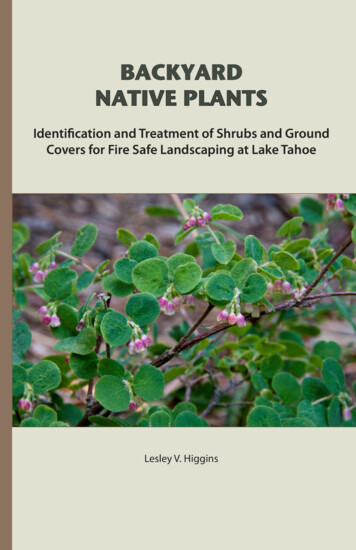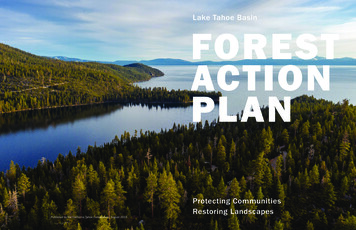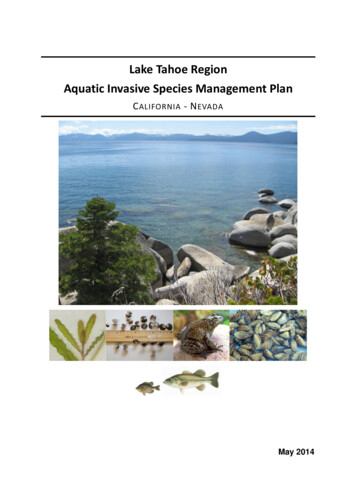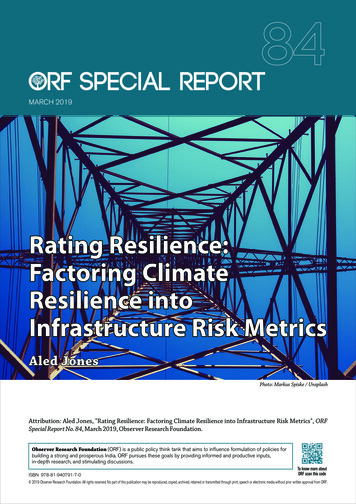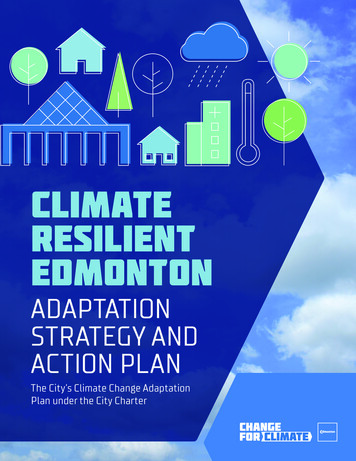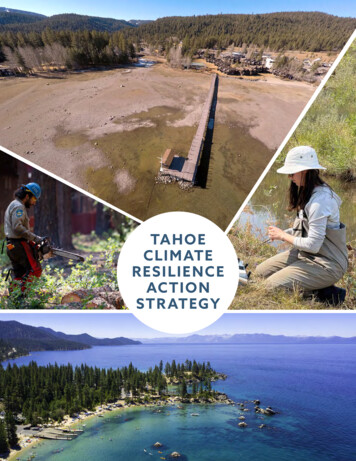
Transcription
TAH O EC LI MATER E S I LI E N C EACTIO NSTR ATEGY1
THE LAKE TAHOE CLIMATE RESILIENCE ACTION STRATEGY builds on existingTahoe Basin climate and environmental improvement plans to identify fivefocus areas that will advance equity, create jobs, and build resilience for theBasin’s extraordinary natural resources, 57,000 residents, and an economy thatsupports 15 million annual visitors. We must act now to preserve and protectLake Tahoe for this and future generations.1. Build Sustainable Recreation andTransportation Systems: Upgrade recreationand transportation facilities to preparefor longer summers, shorter winters,fluctuating lake levels, and changes in visitorpatterns. Invest in projects that expandequitable access like bike paths, accessibilityimprovements, and tribal interpretive sites.2. Reduce Wildfire Risk and Build ForestResilience: Implement unfunded thinningand forest restoration projects to protectcommunities from wildfire and improveforest health. Restore burned forests.Continue implementing the Lake TahoeForest Action Plan.2invasive species. Help wildlife, naturalinfrastructure, and culturally significantplaces withstand droughts, fire, and warmingtemperatures, while storing more carbon inmeadows and forests.4. Upgrade Infrastructure and ProtectVulnerable Communities: Prepare for wildfireand extreme weather by upgrading water,sewer, broadband, and power infrastructure;building community resilience centers;planning for emergencies; and expandingelectric vehicle charging and solar energyadoption.3. Increase Watershed Resilience andBiodiversity: Restore wetlands, streams,and meadows. Prevent and control aquatic5. Advance Science, Stewardship, andAccountability: Guide and protect Tahoeclimate investments through cuttingedge research, monitoring, and adaptivemanagement.Retrof it ting recreation infrastructure to handlefluctuating lake levels safeguards the region’seconomy and protects public access. Photo: Pier atK ings Beach State Recreation AreaRetrof it ting roads to withstand ex treme weatherprotects people and infrastructure investments.(Photo: Construction along NV State Route 28,Nevada Depar tment of Transpor tation)2
Phot o by L a ke Ta ho e Wat e r Tra ilTAK I N G AN I NTEG R ATED APPROAC H TOBU I LD I N G RES I LI EN C EL AKE TAHOEincluding its chemistr y, hydrology,water quality, and native fish.FORESTED UPL ANDSincluding vegetation, wildlife,and groundwater.COMMUNITIESincluding cultural landscapes,public health and safety, recreation,and water, power, communication,and transpor tation infrastructure.Building resilience at Tahoe focuses on three main systems: Lake Tahoe, ForestedUplands, and Communities. Projects within each system yield multiple benefits andadvance California and Nevada priorities, such as:E xpanding public access for people of allraces, cultures, incomes, and abilities.Elevating the role of natural lands infighting climate change and advancingbiodiversit y conser vation through landconser vation.Restoring and using natural infrastructurelike wetlands, beaches, and forests toboost resilience to drought, flood, ex tremeheat, and changing visitor pat terns.Safeguarding jobs, rural economies, andvulnerable communities, and advancingequit y.3
TAHOE HAS SHOVEL-READY CLIMATERESILIENCE PROJECTSThe Lake Tahoe Environmental Improvement Program(EIP) is an unparalleled par tnership working to achievethe region’s environmental goals. The EIP ProjectTracker ser ves as a clearinghouse of information onpast accomplishments as well as proposed, shovelready projects at Tahoe: ramCLIMATE PL ANNING AT L AKE TAHOETahoe Climate Resilience Action St rategy:Strategies and resources needed to adaptTahoe Climate Adaptation Primer Tahoe ClimateAdaptation Action Por t folio:Ongoing and planned actions to accelerate adaptationIntegrated Vulnerabilit y Assessment:Scientific assessment of climate threats at TahoeFoundational Plans: Nevada State Climate Strategy, California ClimateAdaptation Strategy, Lake Tahoe Regional Plan, and Sustainabilit y Action Plan,alongside local plans provide frameworks for climate resilience at Tahoe.Find these and other climate resilience planning documents at trpa.gov/climate-resilience.4Phot o by Ta ho e Re gio na l Pl a nning Ag e nc y
C O S T O F C L I M AT E I M P A C T S O N P E O P L ETahoe snowpack in January 2018.Photo by Tom ReynoldsWildfire, landslides, avalanches, and floodsthreaten the safety of Tahoe’s residents andvisitors and the infrastructure they rely on.Loss of lake clarity due to warming watertemperatures will impact the region’s 5 billiontourism-based economy.Annual road damages are increasing and couldexceed 75 million by 2100. It would cost threetimes less to protect infrastructure from floodsthan to pay for damages from a major flood.Housing costs will rise because people movefrom hotter cities to Tahoe. Higher costsdisplace Tahoe’s workforce and underservedpopulations.Each year, 15 million people visit Tahoe,including hundreds of thousands on busysummer weekends. Wildfire, smoke, andextreme weather events threaten publichealth and safety.Wildfire threatens 26.9 billion in propertyvalue. Each 1 million invested in climateadaptation projects will reduce propertydamage by 10 million.Winter recreation seasons are already shorterand will be cut in half by 2100, causing the skiindustry 268 million in annual losses.The 2021 Caldor Fire demonstrated the urgent need toreduce wildfire risk and improve forest resilience.Meadow degradation threatens sites that areculturally significant to the Washoe Tribe ofNevada and California (Washoe Tribe).Extreme weather increases the risk of landslidesdamaging roads. Photo: Nevada Department ofTransportation55
S H A R E D F U N D I N G N E E D S 2 0 2 2 -2 0 31Now is the time to confront the climate crisis. Tahoe par tners have identifiedshovel-ready projects within the five focus areas below to make our communitiesand natural resources more resilient to climate change. Par tners determinedfunding needs for each strategy based on Lake Tahoe Basin plans and projectlists such as the Lake Tahoe Environmental Improvement Program, Tahoe ClimateAdaptation Action Por t folio, the Lake Tahoe Forest Action Plan, and Lake TahoeAquatic Invasive Species Action Agenda.TotalNeededAnnually2022-26Annually2027-31 125 M 16 M 9 MReflects unfunded needconsidering 2021 stateand federal investmentsin this category 4 M 9 MIncrease Watershed Resilienceand Biodiversity 90 M 12 M 6 MUpgrade Infrastructure andProtect Vulnerable Communities 102 M 13 M 7.4 MAdvance Science, Stewardship,and Accountability 16 M 1.6 M 1.6 M 398 M 46.6 M 33 MImproving Resilience at Lake TahoeBuild Sustainable Recreation andTransportation SystemsReduce Wildfre Risk and BuildForest ResilienceTOTAL:6 65 M
REGIONAL COORDINATION IS IN TAHOE’S DNAThe EIP serves as the backbone for regional climate adaptationcoordination. Federal, tribal, state, local, and private partners havecollaborated since 1997 to restore the environmental health ofLake Tahoe. Together, EIP partners have made progress—the Lake’sclarity loss has stabilized, mountain streams are clearer, and forestmanagement is underway. Continued investment will help build onthe EIP’s progress and create a more resilient landscape at Tahoe.Learn more at LakeTahoeInfo.org.Lake Tahoe E IP Par t ner Organizations Include:FEDERAL AGENCIESU.S. Army Corps of EngineersBureau of Land ManagementBureau of ReclamationFederal Highway AdministrationFederal Transit AdministrationNatural Resources ConservationServiceNational Aeronautics and SpaceAdministration (NASA)USDA Forest ServiceU.S. Environmental Protection AgencyU.S. Geological SurveyU.S. Fish and Wildlife ServiceTRIBALWashoe Tribe of Nevada and CaliforniaSTATES OF CALIFORNIA AND NEVADACAL FIRECalifornia Air Resources BoardCalifornia Conservation CorpsCalifornia Department of Fish andWildlifeCalifornia Department of WaterResourcesCalifornia Environmental ProtectionAgencyCalifornia Natural Resources AgencyCalifornia State Lands CommissionCalifornia State ParksCalifornia Tahoe ConservancyCalifornia Wildlife Conservation BoardCaltransState of California Lahontan RegionalWater Quality Control BoardUniversity of California, Davis TahoeEnvironmental Research CenterNevada Department of Conservationand Natural ResourcesNevada Division of ForestryNevada Division of State LandsNevada Division of State ParksNevada Department of WildlifeNevada Department of TransportationNevada Division of EnvironmentalProtectionNevada Public Utilities CommissionUniversity of Nevada, RenoDesert Research InstituteREGIONAL AGENCIESTahoe Regional Planning AgencyTahoe Transportation DistrictLOCAL GOVERNMENTS/ORGANIZATIONSCarson CityCarson City Fire DepartmentCave Rock Estates GeneralImprovement DistrictCity of South Lake TahoeDouglas CountyEl Dorado CountyFallen Leaf Fire DepartmentIncline Village General ImprovementDistrictKingsbury General ImprovementDistrictLake Valley Fire Protection DistrictLakeridge General ImprovementDistrictMeeks Bay Fire Protection DistrictNevada Tahoe Conservation DistrictNorth Lake Tahoe Fire ProtectionDistrictNorth Lake Tahoe Resort AssociationNorth Tahoe Fire Protection DistrictNorth Tahoe Public Utility DistrictPlacer CountyRound Hill General ImprovementDistrictSouth Tahoe Public Utility DistrictTahoe Science Advisory CouncilTahoe City Public Utility DistrictTahoe Douglas Fire Protection DistrictTahoe Resource Conservation DistrictTown of TruckeeWashoe CountyPRIVATE ENTITIESEdgewood CompaniesHeavenly Mountain ResortLake Tahoe Marina AssociationLake Tahoe South Shore Chamber ofCommerceLeague To Save Lake TahoeLiberty UtilitiesNV EnergySugar Pine FoundationTahoe FundTahoe Institute for Natural ScienceTahoe Keys Property OwnersAssociationTahoe Lakefront Owners’ AssociationTahoe PartnershipTahoe Rim Trail Association7
Front cover, top photo by Aerial Flight Productions (CC BY 2.0)Front cover bottom photo and back cover photo by Lake Tahoe Water TrailenvironmentalimprovementprogramPublished by the California Tahoe Conser vancy, Februar y 20228
THE LAKE TAHOE CLIMATE RESILIENCE ACTION STRATEGY builds on existing Tahoe Basin climate and environmental improvement plans to identify five focus areas that will advance equity, create jobs, and build resilience for the Basin's extraordinary natural resources, 57,000 residents, and an economy that


